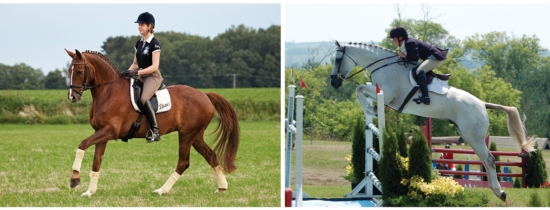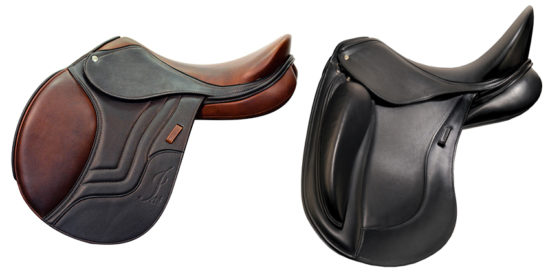Saddle Fit and the Various Disciplines
The question was put to me recently whether or not it was `harmful` or `wrong` to jump in your dressage saddle or do dressage in your jumping saddle. Theoretically at least – presuming that these are not necessarily regular activities but rather just ‘one-off’ activities – there should be no problem with no real long-reaching ramifications. However, if you think to make this a full-time activity, there are solid reasons behind choosing a saddle which is specific to the discipline you are riding – both for you and the horse.
Your Personal Saddle Checklist:
Use these points to help you decide whether or not a particular saddle is going to work for – (D) dressage or (J) jumping:
- Does your leg hang comfortably and loosely straight down? (D)
- Does your flap allow your leg to support you in a 2-point position over the jump? (J)
- Is the saddle comfortable for you between your upper inner thighs (this is where the twist is) or do you feel ‘pulled apart’ in this area (soreness in the hips?) (D/J)
- Can you feel your seat bones? (D/J)
- Are the stirrup bars in the correct position to allow you to achieve the shoulder-hip-heel straight line? (D)
- Is your knee comfortably placed on the flap or is it angled outwards? (D/J)
- Is there flap visible behind your leg when you are in the stirrups? (D/J)
- Can you effect a pelvic tilt (forwards and backwards movement) comfortably without pain at your pubic symphysis or in the crotch area? (D)
- Do the thigh/knee rolls impede movement at the hips, at the knees, at the ankle? Are they too long, too big or too small? Do they support you or are they in the way? (D/J)
- Can you post comfortably (D)
- Is there enough room in front and behind your pelvis so that during trotting you don’t hit your pubic bone? (D/J) So that during sitting trot you are not thrown out of the saddle at the cantle area? (D)
- Is the saddle flap long enough to avoid having your boot top catch on it? (D/J)
- Is the seat seam uncomfortable and noticeable? (D/J)
- Are you in balance during the walk? (D/J) Do you have enough support from the saddle to be able to sit properly in position while the horse is walking? (D/J)

Once you have answered these questions for yourself and feel comfortable in the saddle, then it is probably a good choice for you. A saddle’s center of balance (deepest point) varies for each saddle type and is determined by discipline as well as gender of the rider. A jumping saddle will always have the deepest point further back than the dressage saddle because this accommodates the ability of the rider to balance in a normal seated position. In a dressage saddle, the rider must be able to sit constantly balanced with her center of gravity aligned with that of the horse.
Whatever the discipline however, the goal should always be for the rider to achieve whatever the momentary balance point for the horse is. This will constantly change during movement and is influenced by correct riding. And correct riding will only be supported with the proper saddle.
Besides having to be comfortable for the rider, the saddle seat has a huge influence on the ability of the rider to sit properly and in balance, to be able to give good aids to the horse, and to become one with the horse so that the exercises are harmonious. Even jumper riders need to exercise their horses in basic dressage – and to do this properly, it should be done in a dressage saddle. (Of course I do recognize that it is a bit of a pain to have to switch saddles if you then want to train jumps…)
There are various interpretations and expectations as to the term ‘seat depth’ all across the industry and in the various disciplines. Some people think seat depth simply indicates how tightly the rider is positioned between saddle pommel and cantle. Others think that seat depth is more an indication of how close the rider actually feels to the horse in his seat, while maintaining enough freedom to move in both the front and back of the saddle. Whatever the definition – whatever seat depth means – the rider should never be wedged into the saddle so that absolutely no movement is possible.
Obviously, because of the length of time spent actually ‘in’ the saddle (dressage) vs. ‘on’ the saddle (jumping), there are many more considerations on fit to the rider for dressage. If the saddle is not comfortable for the rider, this discomfort will translate down to the horse and generally impede his comfort and ability to perform. Many more manufacturers are finally taking the horse’s needs into consideration in their dressage saddle construction, with shoulder relief panels and wider gullet channels – but there is still some way to go.
With jumping saddles, because of the fact that you are often in a two-point position and out of the saddle, the horse’s needs probably play a bigger role in determining proper fit. Unfortunately, too many of the jumping saddles I see on the market have totally disregarded the basic conformational requirements of the horse. Too many jumper riders still accommodate ‘fitting issues’ with pad after pad after pad – paradoxically negating the entire idea of ‘close contact’ jumping saddles. Even the most prestigious jumping saddle manufacturer in the world has seemingly never studied equine anatomy; their gullet channel is still maybe two fingers wide, the tree points are forward facing, and there is no shoulder relief to accommodate the shoulders moving upwards and backwards during a jump.
Most jumping saddles are still placed way too far forward over the shoulders – and the irony here is that then even more pads are needed to bring the back of the saddle up to make it at least appear balanced and in a straight line from pommel to cantle. I was amazed to see one of our top jumper riders (who shall remain nameless) at a show just after I arrived from Germany in 1986 with – I kid you not! – two keyhole pads, a foam pad, and a sheepskin pad under his ‘close contact’ saddle. In Germany the jumping saddles I was used to were completely different to what was being used here in North America – most were much ‘bigger’ and wool filled to be adjustable for fit like the dressage saddles, whereas here the fashion was the thinner close contact French-style jumping saddles. (I think that’s probably why our jumping saddles never really reached the popularity of our dressage line).
In any case – a soft supple seat can only be achieved when the rider moves in harmony with her horse – with both in balance. The stirrup bars need to be the right length and in the right position, the twist needs to be the correct width, the seat width needs to be appropriate, and the cantle height also plays a role – regardless of discipline. You simply will not have the necessary support in a dressage saddle to work with the horse over a jump; you simply will not be able to do proper dressage in a close contact jumping saddle which does not allow the rider to sit properly balanced with a shoulder-hip-heel straight line.
It would be like running in high heels – sure you can do it for a short distance; dancing ballroom in running shoes – you would never be able to glide across the dance floor. Things have been made a certain way for a reason and to fulfill their purpose. So the short answer to the original question remains ‘depends’. A lot of external factors need to be taken into consideration. A compromising option if budget is an issue might simply be to go with an ‘all purpose’ saddle – but even these can be made with a little more dressage or jumping feel, depending on what it is you’re likely to do the most.

©2016 Saddlefit 4 Life® All Rights Reserved
